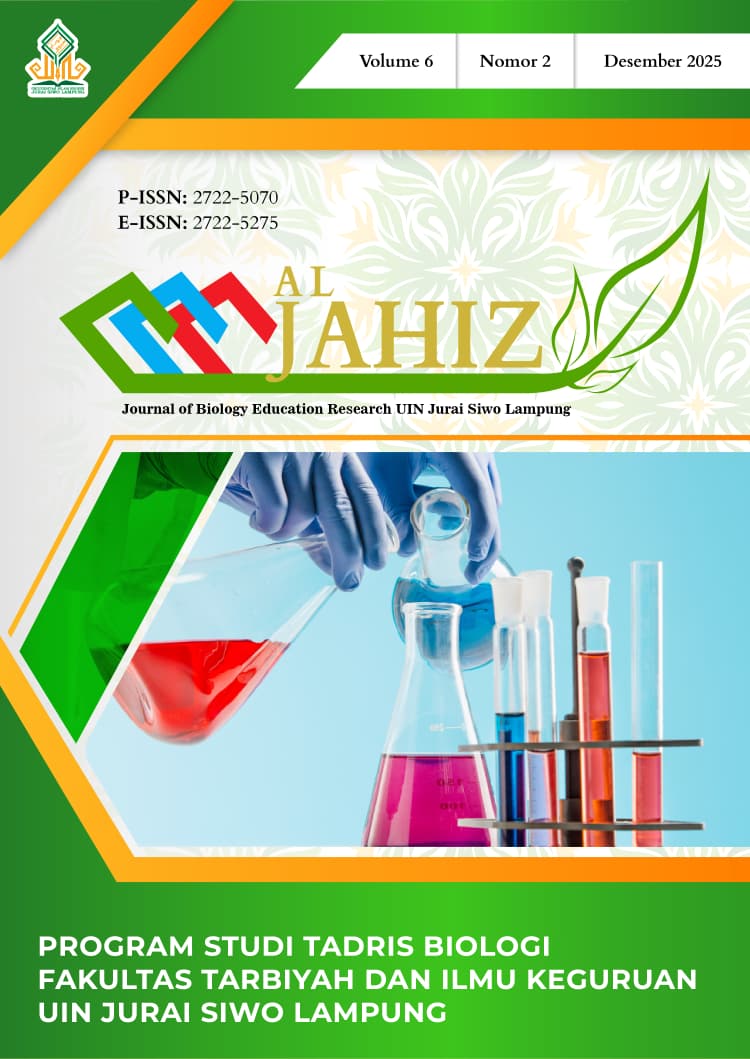Addressing Misconceptions in Biology Using Design Thinking as A Framework
DOI:
https://doi.org/10.32332/al-jahiz.v6i2.10471Keywords:
misconception, design thinking process, biology, mixed methodologyAbstract
Despite the importance of science in our everyday life, a decline in students’ academic performances and interest towards Biology have been empirically publicized by several researchers. Though multifactorial, misconception remains one of the key factors affecting students’ understanding of concepts, exam grades and interest. Consequently, the literature is gauged with empirical research focusing on the appropriateness of different methods and strategies used to identify and clear students’ misconceptions in Biology. This case study uses a mixed epistemological stance to study the appropriateness of using the DTSICM (Design Thinking Strategy to Identify and Clear Misconceptions) model, underpinned by the Stanford’s design thinking framework, in identifying and clearing the misconception of twelve low-performing students in Biology. The findings revealed that (i) the use of design thinking-based DTSICM approach is efficient in clearing students’ misconceptions, with statistical significance at 5% level ( p>0.05), and (ii) the design thinking approach provide teachers with a formalised, context-driven, needs-based and adaptable pathway to identify and clear misconceptions of students, by engaging through the five decisive stages of the design thinking framework, namely ‘emphasize’, ‘define’, ‘ideate’, ‘prototype’ and test’.
References
Atchia (2021). Integration of ‘design thinking’ in a reflection model to enhance the teaching of biology, Journal of Biological Education, DOI: 10.1080/00219266.2021.1909642
Atchia (2022). Development and testing of the DTSICM model: A Design thinking Strategy to Identify and Clear Misconceptions in Science. ICOSS conference proceedings, forthcoming
Atchia, S. M. C., Chummun, D., & Luckho, S. (2024). Use of design thinking as a strategy to identify and clear students’ misconceptions in photosynthesis: A case study. Journal of Biological Education, 58(3), 666-683.
Balcı, S. (2005). Improving 8th grade students' understanding of photosynthesis and respiration in plants by using 5E learning cycle and conceptual change text. Master's thesis, Middle East Technical University.
Brenner, L. (2020). Why Is Photosynthesis Important For All Organisms? Sciencing. Available at: https://sciencing.com/photosynthesis-important-organisms-6389083.html.
Bullough Jr, R. V. (2012). Mentoring and new teacher induction in the United States: A review and analysis of current practices. Mentoring & tutoring: partnership in learning, 20(1), 57-74.
Dam, R., & Siang, T. (2018). What is design thinking and why is it so popular? Interaction Design Foundation.
Ekici, F., Ekici, E., & Aydın, F. (2007). Utility of Concept Cartoons in Diagnosing and Overcoming Misconceptions Related to Photosynthesis. International Journal of Environmental & Science Education, 2(4), 111-124
Giannakos, M.N. (2013). Exploring the video‐based learning research: A review of the literature. British Journal of Educational Technology, 44(6), 191-195.
Halim, A., Finkenstaedt-Quinn, S., Olsen, L., Gere, A. & Shultz, G. (2018). Identifying and Remediating Student Misconceptions in Introductory Biology via Writing-to-Learn Assignments and Peer Review. CBE—Life Sciences Education, 17(2), 28.
Hasso Plattner Institute of Design at Stanford. (2011). Bootcamp Bootleg. http://dschool.stanford.edu/wp-content/uploads/ 2011/03/BootcampBootleg2010v2SLIM.pdf
Henriksen, D., Richardson, C. & Mehta, R. (2017). Design thinking: A creative approach to educational problems of practice. Thinking skills and Creativity, 26, 140-153.
Hershey, D. R. 2004. Avoid misconceptions when teaching about plants [online]. Website http://www.actionbioscience.org/education/hershey.html.
Hussain, A., Azeem, M., & Shakoor, A. (2011). Physics teaching methods: scientific inquiry vs traditional lecture. International Journal of Humanities and Social Science, 1(19), 269-276.
Karakaya, F., Yılmaz, M. E. H. M. E. T., & Elvan, E. L. V. A. N. (2021). Examination of pre-service science teachers conceptual perceptions and misconceptions about photosynthesis. Pedagogical Research, 6(4).
Kautz, C.H & Timmermann, D. (2015). Multiple Choice Questions that Test Conceptual Understanding: A Proposal for Qualitative Two-Tier Exam Questions. American Society for Engineering Education, 13350, 1 - 14.
Keleş, E. & Kefeli, P. (2010). Determination of student misconceptions in “photosynthesis and respiration” unit and correcting them with the help of cai material. Procedia - Social and Behavioral Sciences, 2(2), 3111-3118.
Köse, S. (2008). Diagnosing Student Misconceptions: Using Drawings as a Research Method. World Applied Sciences Journal, 3(2), 283-293.
Lindberg, T., Noweski, C., & Meinel, C. (2010). Evolving Discourses on design thinking: how design cognition inspires meta-disciplinary creative collaboration. Technoetic Arts: A Journal of Speculative Research, 8(1), 31–37
Marmaroti, P. & Galanopoulou, D. (2006). Pupils' Understanding of Photosynthesis: A questionnaire for the simultaneous assessment of all aspects. International Journal of Science Education, 28(4), 383-403.
Mauritius Examination Syndicate. (2021). Statistics. Available at: http://mes.intnet.mu/English/Statistics/Pages/default.aspx
Nguyen, S. P., & Rosengren, K. S. (2004). Parental reports of children’s biological knowledge and misconceptions. International Journal of Behavioral Development, 28, 411–420.
Ogundare, A., Bello, G., Adeoye, G. A., & Sulaiman, M. M. (2024). Remediating students’misconceptions in biology: a review. Custech International Journal of Education, 1(2), 122-134.).
Patil, S.J., Chavan, R.L.& Khandagale, V.S. (2019). Identification of misconceptions inscience: Tools, techniques & skills for teachers. Aarhat Multidisciplinary International Education Research Journal (AMIERJ), 8(2), 466-472.
Plattner, H., Meinel, C., & Weinberg, U. (2009). Design Thinking: Innovation lernen Ideenwelten öffnen. Finanzbuch Verlag, Munich.
Prayitno, T. A., & Hidayati, N. (2022). Analysis of students' misconception on general biology concepts using four-tier diagnostic test (FTDT). IJORER: International Journal of Recent Educational Research, 3(1), 1-10.
Rouvray, D. H. (1992). Definition and role of similarity concepts in the chemical and physical sciences. Journal of chemical information and computer sciences, 32(6), 580-586.
Tschimmel, K. (2012). Design Thinking as an effective Toolkit for Innovation. In ISPIM Conference Proceedings. The International Society for Professional Innovation Management (ISPIM).
Venter, B. (2023). An analysis of Life Sciences textbooks' representation of the relationship between photosynthesis and respiration (Master's thesis, University of Pretoria (South Africa)).
Yates, T. & Marek, E. (2014). Teachers teaching misconceptions: a study of factors contributing to high school biology students’ acquisition of biological evolution-related misconceptions. Evolution: Education and Outreach, 7(1), 1-18.
Downloads
Published
Issue
Section
License
Copyright (c) 2025 Shakeel Atchia, Heeroo E. Charles, Mowlabucus M. Hourani

This work is licensed under a Creative Commons Attribution-ShareAlike 4.0 International License.


















